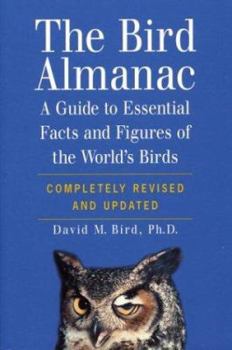The Bird Almanac: A Guide to Essential Facts and Figures of the World's Birds
Select Format
Select Condition 
Book Overview
Besides a mammoth listing of bird species worldwide, "The Bird Almanac" includes detailed information on all aspects of avian physiology -- including anatomy, reproduction, and disease -- as well as a... This description may be from another edition of this product.
Format:Paperback
Language:English
ISBN:1552979253
ISBN13:9781552979259
Release Date:March 2004
Publisher:Firefly Books
Length:460 Pages
Weight:1.35 lbs.
Dimensions:1.1" x 5.1" x 8.2"
Related Subjects
Almanacs Almanacs & Yearbooks Birdwatching Nature Nature & Ecology Ornithology Reference ZoologyCustomer Reviews
3 ratings
Excellent Book----All That I hoped For and More
Published by Thriftbooks.com User , 17 years ago
The subtitle of this book lives up to expectations---"A Guide to Essential Facts and Figures of the World's Birds". The sections on anatomy and records are awesome. Everything I expected from this book is in here and much more.
Fascinating Bird Facts & Useful Info for Birders
Published by Thriftbooks.com User , 21 years ago
In "The Bird Almanac", ornithologist David Bird has attempted to create a reference volume packed with a wide variety of information that bird enthusiasts of every level of expertise will find interesting and useful. The first 213 pages of this 460-page book is a World Checklist of Birds, which lists all of the world's bird species by their order and includes notation as to their threatened, endangered, or other status where it is applicable. This is followed by 70 pages dedicated to information about the birds themselves. There is a useful chart giving American and British equivalencies in names of birds. There are diagrams, definitions, and many fascinating statistics on bird anatomy and physiology. There are more diagrams and statistics relating to eggs and incubation as well as statistics on mortality and avian diseases. And there are several pages listing truly amazing world records among birds that are sure to make a trivia buff out of you. The next 142 pages contain information about birding, past and present. Included is a Who's Who in Bird Biology and Conservation, information about major ornithological organizations, the birding codes of ethics from both the American Birding Association and the Royal Society for the Protection of Birds, and tips for attracting and feeding birds. There are also extensive listings of bird-watching and bird-banding organizations around the globe, birding hotlines, magazines, newsgroups, festivals, and tours. And there is a glossary of terms in the back of the book. Most of the information in "The Bird Almanac" pertains to North America and Great Britain. The book might have been more aptly named "The Birding Almanac", since it contains more information on birding than about the birds themselves. But the bird information that is here is quite fascinating and has been gleaned from so many different sources that it would be difficult to find elsewhere. Where else could I learn that a peregrine falcon can dive at speeds of 117 mph (wow!), that the largest nesting colony contained 136 million passenger pigeons (scary), or that a group of cormorants is called a "gulp" (funny)? Ornithologists, birders, backyard bird watchers, students, conservationists, and those whose curiosity is stirred by fascinating facts are sure to find something of interest in "The Bird Almanac".
This book belongs in every bird watcher's library.
Published by Thriftbooks.com User , 25 years ago
The amount of information in The Bird Almanac, and the diversity, is staggering, and there is far too much to cover in a short review. The information covers both birds and bird watching, starting with a complete checklist of the world's birds. There is a chart showing the suggested fossil history of birds. The sections on anatomy include not only the traditional bird diagram, but also labeled drawings of the skeleton, digestive system, brain, eyeball, feather tracts, and other systems. There are charts on heart rates, metabolic rates, hearing range, and number of taste buds in various species, and dozens of others in the physiographic section. There are also charts on wing loading, flight speed, daily flight distance, average altitudes of migrating birds, and the ability of birds to transport prey after capture. The mortality section includes charts on the relative occurrence of a long list of diseases and lists of threatened and endangered birds.There is a section on biggest, smallest, longest, most traveled birds, etc. A section on who's who in bird biology and conservation includes not only the expected names, but important figures less well-known. Do you want to know who was president of the AOU in 1938, or any other year? Who are the recipients of the Elliot Coues Award? It's all here, as well as which teams have won the World Series of Birding and who has won the Duck Stamp competition. There is a section on resources for bird watchers that includes a list of the world's bird watching and ornithological organizations, with addresses, lists of Internet resources, a compilation of the world's bird watching magazines, lists of rare bird alerts, tour companies, CD ROMs, and on and on.This is one of the most impressive, and useful, one-volume collection of information about birds and bird watching available anywhere. Readers will find themselves delving into it for pleasure over and over, and it will be one of the most frequently used references on the shelf. My copy is going on the shelf next to the Birder's Handbook and the small set of references that are my first line of defense whenever anyone asks a question or I need a quick answer. This book belongs in every bird watcher's library.-Eirik A.T. Blom






